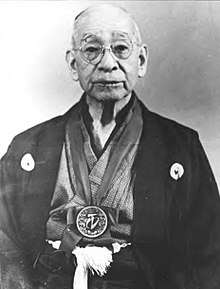Kobayashi Shōrin-ryū
Kobayashi (小林) Shōrin-ryū (小林流) (Shōrin-ryū) is the school of Okinawa Shorin-ryu karate founded by Chōshin Chibana. The style is properly called Shorin-Ryu.
 Kobayashi Shorin-ryū founder Choshin Chibana | |
| Also known as | Kobayashi Shorin-ryu |
|---|---|
| Date founded | 1915 |
| Country of origin | Okinawa, Japan |
| Founder | Chōshin Chibana |
| Arts taught | Karate |
| Ancestor schools | Shōrin-ryū |
| Descendant schools | Shidōkan, Shōrinkan, Kyudokan |
| Practitioners | Katsuya Miyahira, Shūgorō Nakazato, Nakama Chozo, Yuchoku Higa, Naonobu Ahagon |
History
After the death of Anko Itosu in 1915, one of Itosu's most senior students, Choshin Chibana, wanted to continue to teach the Shorin-ryū style of karate he learned from his instructor. Chibana named his system Shorin-ryū, but using the Chinese characters for "small" (小[1]) and "forest" (林[2]). Chibana lineage schools are commonly referred to as "kobayashi," but this is technically incorrect, as Chibana never used this term to refer to his karate. It was meant to be “Shorin” as tribute to the Shaolin Temple. (Shorin is the Japanese and Okinawan pronunciation of Shaolin). However, he believed strongly that Shorin-ryu was largely Okinawan and purposely modified the first character from the Chinese "Shao/Sho" so it would retain its originality. As other schools later adopted the name "Shorin-ryū," the term "kobayashi" was probably added to describe which exact characters were used to write the term "Shorin," but was never meant to be the official name of the style.
In 1920, Chibana opened his first dojo in the Torihori district of Shuri. Spellings such as "Tottoribori" or "Tottori-cho" are erroneous and incorrect. The old name of Torihori was Tunjumui, so it is unknown where these erroneous names originated. He later taught in other parts of Shuri such as Gibo and Yamakawa, and in Naha at Kumoji and Asato, with the main Chibana dojo being in Yamakawa.[3][4]
Chibana taught this style of Shorin-ryū until his death in 1969. Each of his top students went on to create his own branch of Shorin-ryū: Nakama Chozo created Shubokan, Yuchoku Higa created Kyudokan, Katsuya Miyahira created Shidō-kan, Isamu Arakaki created Shorin-ryu Kodokan, Shūgorō Nakazato created Shorinkan and Joki Uema created Shubukan.[5]
About the name
"... now the Japanese call it 'kobayashi style' but that is incorrect - but that is all right because only people who do not know Okinawan karate will call it by that name. Since they do not know you must gently remind them or the Okinawan people will laugh at their ignorance. After all, it is funny, many foreign people call it kobayashi shorin-ryu (小林小林流)- that is just like saying shorin shorin-ryu. It doesn't make much sense ..." [6][7]
The kanji are never written as 小林小林流 (kobayashi shorin-ryu) but always as 小林流 (shorin-ryu). The term Kobayashi Shorin-ryu is only used in the west and only by certain branches of Shorin-ryu. The Japanese reader of the kanji 小林流 automatically knows it is not Matsubayashi-ryu 松林流 because the kanji are different.
References
- SHO, chiisai, ko, o - http://www.thejapanesepage.com/node/kanji/kk52.htm
- RIN, hayashi - http://www.thejapanesepage.com/node/kanji/k673.htm
- Murakami Katsumi, Karate no Kokoro to Waza, 1991.
- Nakamoto Masahiro, Okinawa Dentou Kobudo, 2006.
- "World Miyazato Dojo". karatemiyazato.com. Archived from the original on December 9, 2004.
- "About the name of Shorin-Ryu". okinawakarate.pl. Archived from the original on December 16, 2008.
- Kobayashi = 小林, Shorin = 小林